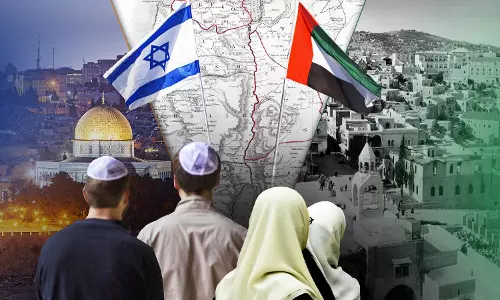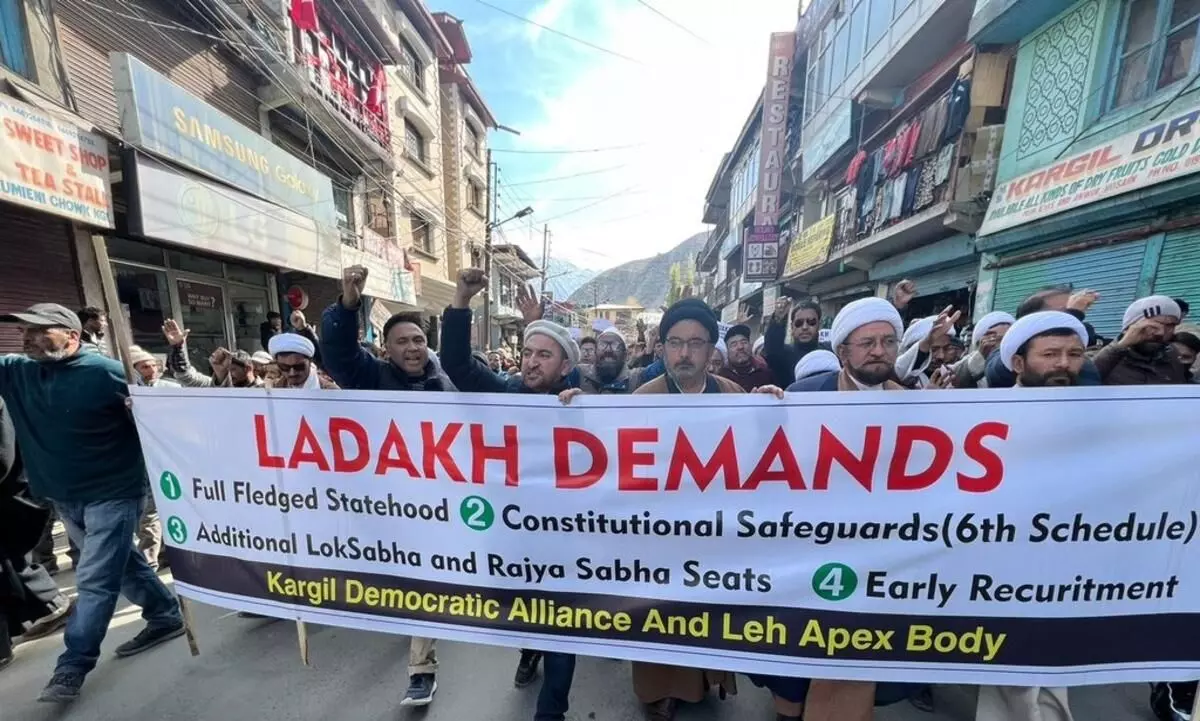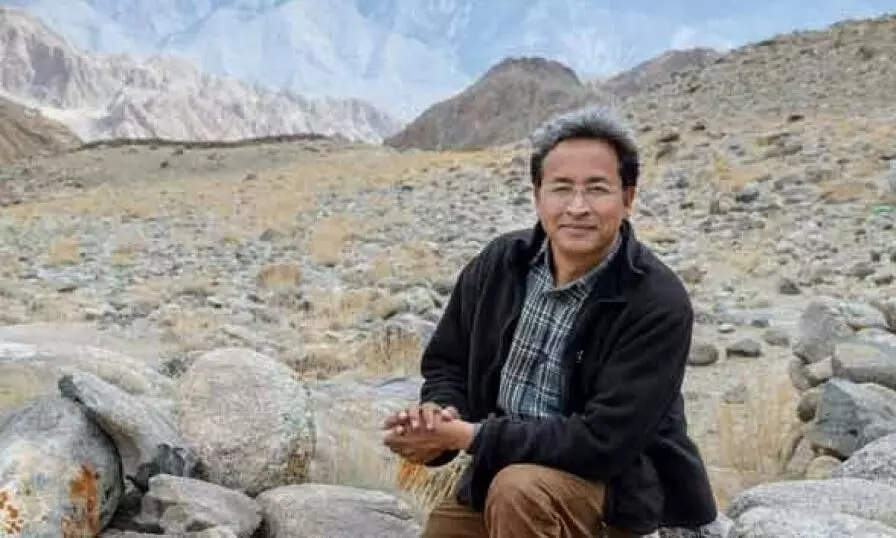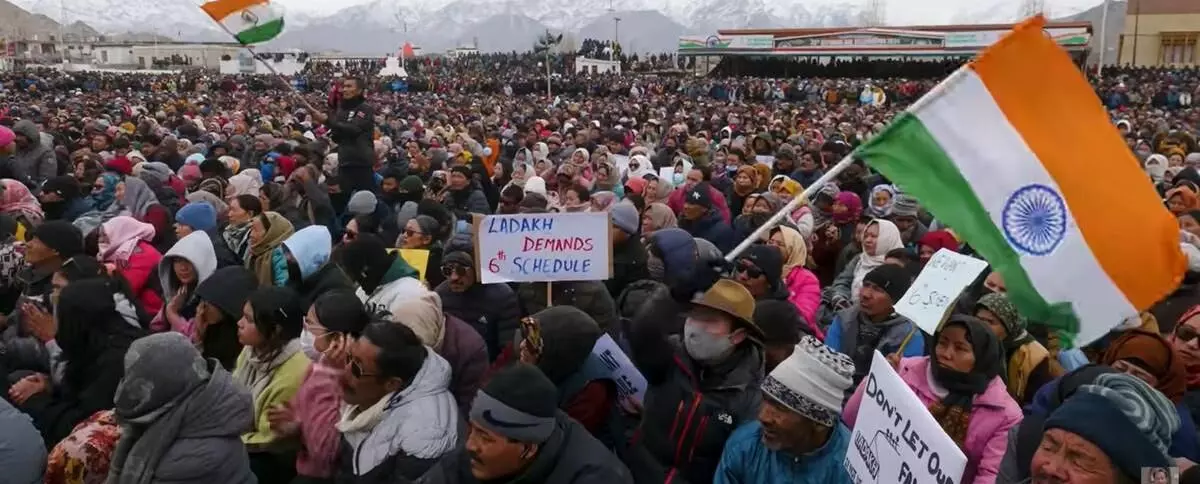
The smouldering of anger in Ladakh
text_fieldsLadakh, India's northernmost region, has been in turmoil for more than a month. People are up in protest and agitation claiming that none of the promises given by the Central government in 2019, when Jammu and Kashmir was divided and Ladakh was made a Union Territory, has been fulfilled. Their demand are mainly full statehood for Ladakh with a population of over three lakh, constitutional protection for 97 per cent tribals, implementation of Schedule VI of the constitution that provides for local self-government bodies with legislative powers in landed property, health and agriculture, labour protection, protection to earth and earth resources, and one parliamentary constituency each in Buddhist-dominated region and Muslim-dominated area of Kargil. Engineer Sonam Wangchuk, an environmental activist has been in hunger strike for the past 21 days, braving snow and huddled inside a blanket. In a video message posted on X, Sonam informed that the first phase of the protest was over on Wednesday and it would enter the second phase on Thursday. Following the 10-day long women's hunger strike, youth organizations and Buddhist monks and adults would join the strike.
When Ladakh was separated from Jammu & Kashmir in August 2019, the Central government had promised more powers and status. However, when it was turned into a union territory, Ladakh lost even the powers and privileges it had earlier. Previously, Ladakh region had four MLAs in the Jammu-Kashmir assembly, but now that has been reduced to just one parliament seat. For this very reason, the locals do not have any say in policy decisions related to the region. In the 2019 Lok Sabha election, the BJP manifesto had contained a promise that Ladakh would be included in Schedule VI of the Constitution. Even when elections were held to the Ladakh Autonomous Hill Development Council the following October, this remained their main promise. But once the elections were over, the BJP went back on its word. The approach adopted towards Ladakh speaks for the fact that the BJP was as much driven by crony capitalist interests as by politics in its decision to separate Ladakh. What would emerge from applying Schedule VI for Ladakh is that any development schemes implemented for the region would be under due consultation with local tribal people. But then that would be harmful to the capitalist interests of Modi government. For this very reason, the Centre is holding Ladakh under its clutches. Thus, for any lobby to start mining or industries, the approval of the Lieutenant Governor would suffice. This development thrust of the BJP has put in danger the ecology of the tribal communities of the northern most part of the country. For example, certain traditional methods are adopted by the Ladakhis for water consumption. Some villages draw on the Indus river, while some others depend on minor water falls, and yet others certain steams. Some share the same sources too. But instead of this, the Centre came out with a water distribution scheme under the Jaljeevan Mission. More terrible is the Centre's policy of giving concessions in large swathes of land to big industries, even denying livelihoods. The world-famous Pashmina fibre of Kashmir comes from a special breed of sheep of Changthang region of Ladakh. When the government gave a concession of 20,000 acres of lush pastureland for solar energy plants of big industries, that comes at the cost of the pastureland where the sheep would graze. And in the Indian border area adjoining China, the shepherds and farmers of the region are also victim to Chinese army's incursions and their troubles.
There is also the issue that because of military deployment upto 10 or 15 kilometers, in the name of border security, the shepherds are not allowed to use the land they have been using until now. Citing these matters, Yi Wangchuck's Apex Body of Leh and Kargil Development Council held discussions with the Union Home Ministry on March 4, but that last round of discussions also ended in failure. It was following this that on March 7, Wangchuk took the lead for a 21-day hunger strike following the model of the longest hunger strike made by Mahatma Gandhi. The organisation has also declared that thousands will march to the Chinese border of Changthang. Wangchuk's argument is that their march is to the land used by Ladakh's shepherds and India did not have to stop the march. Or if it is blocked, that would be tantamount to proving the alienation of land by China. For a month, the Centre has been ignoring the Gandhian strike and agitation marches of the people of Ladakh. But with it is burning the protest of Ladakhis who view the BJP regime with scorn. Despite the embedded media of the BJP ignoring the popular agitation with the participation of thousands of people, it has won the attention of the world. What this struggle for rights upsets is not only the claims about Modi's guarantee, but also the tempo of the surge to a third term touted as unstoppable.


























